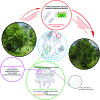Understanding Microbial Multi-Species Symbioses
- PMID: 26925047
- PMCID: PMC4757690
- DOI: 10.3389/fmicb.2016.00180
Understanding Microbial Multi-Species Symbioses
Abstract
Lichens are commonly recognized as a symbiotic association of a fungus and a chlorophyll containing partner, either green algae or cyanobacteria, or both. The fungus provides a suitable habitat for the partner, which provides photosynthetically fixed carbon as energy source for the system. The evolutionary result of the self-sustaining partnership is a unique joint structure, the lichen thallus, which is indispensable for fungal sexual reproduction. The classical view of a dual symbiosis has been challenged by recent microbiome research, which revealed host-specific bacterial microbiomes. The recent results about bacterial associations with lichens symbioses corroborate their notion as a multi-species symbiosis. Multi-omics approaches have provided evidence for functional contribution by the bacterial microbiome to the entire lichen meta-organism while various abiotic and biotic factors can additionally influence the bacterial community structure. Results of current research also suggest that neighboring ecological niches influence the composition of the lichen bacterial microbiome. Specificity and functions are here reviewed based on these recent findings, converging to a holistic view of bacterial roles in lichens. Finally we propose that the lichen thallus has also evolved to function as a smart harvester of bacterial symbionts. We suggest that lichens represent an ideal model to study multi-species symbiosis, using the recently available omics tools and other cutting edge methods.
Keywords: Alphaproteobacteria host-associated bacteria; lichens; microbiome; symbiosis.
Figures

References
-
- Aschenbrenner I. A. (2015). Stability and Change in the Lichen Microbiome. Doctoral thesis, Graz University of Technology, Graz, 48–107.
-
- Bates S. T., Berg-Lyons D., Lauber C. L., Walters W. A., Knight R., Fierer N. (2012). A preliminary survey of lichen associated eukaryotes using pyrosequencing. Lichenologist 44 137–146. 10.1017/S0024282911000648 - DOI
Publication types
Grants and funding
LinkOut - more resources
Full Text Sources
Other Literature Sources

